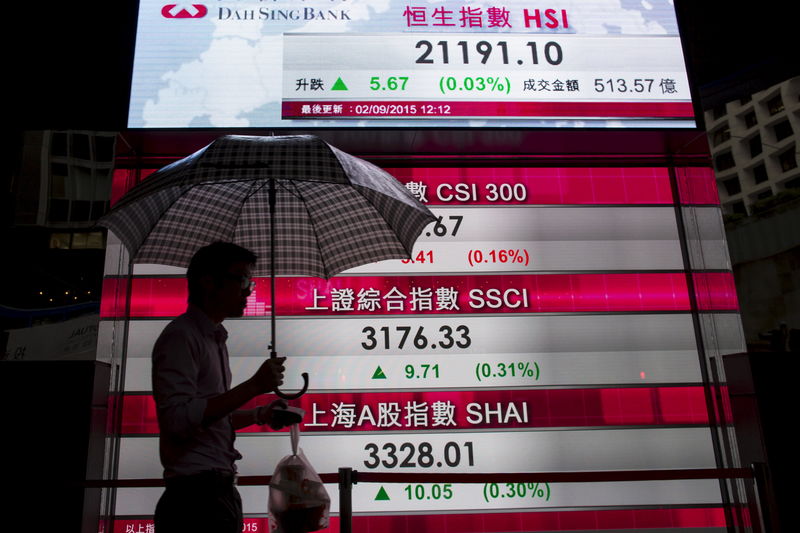EUR/USD likely to find a peak near 1.25: UBS
* Asian stock markets : https://tmsnrt.rs/2zpUAr4
* China exports rise 3.5% y/y vs forecast -15.7%
* Stocks steady after choppy start, U.S. jobs data awaited
* Long-term U.S. yields lifted by tidal wave of new debt
By Wayne Cole
SYDNEY, May 7 (Reuters) - Asian shares pared early losses on
Thursday after Chinese exports proved far stronger than even
bulls had imagined, while U.S. bond investors were still daunted
by the staggering amount of new debt set to be sold in coming
weeks.
Beijing reported exports rose 3.5% in April on a year
earlier, completely confounding expectations of a 15.1% fall and
outweighing a 14.2% drop in imports. The surprise stoked speculation the Asian giant could
recover from its coronavirus lockdown quicker than first thought
and support global growth in the process.
The news helped some regional markets steady after a shaky
start with both Japan's Nikkei .N225 and South Korea .KS11
back to flat.
MSCI's broadest index of Asia-Pacific shares outside Japan
.MIAPJ0000PUS eased 0.4%, led by a 0.3% dip in Chinese blue
chips .CSI300 .
E-Mini futures for the S&P 500 ESc1 fared better with a
bounce of 0.5%, while EUROSTOXX 50 futures STXEc1 and FTSE
futures FFIc1 both firmed 0.2%.
Markets had started cautiously with renewed Sino-U.S.
tensions lurking in the background.
U.S. President Donald Trump said he would be able to report
in about a week or two whether China is meeting its obligations
under a trade deal, as Washington weighed punitive action
against Beijing over its handling of the coronavirus outbreak.
The flow of economic data also remained grim, with U.S.
private employers laying off 20 million workers in April.
Figures due later on Thursday are forecast to show initial
jobless claims rose a further 3 million last week, while
Friday's payrolls report is expected to see 22 million jobs lost
and unemployment hit 16% or higher.
On Wall Street, energy and utility sectors were the main
losers while demand for techs kept the Nasdaq in the black.
The Dow .DJI had ended down 0.91% and the S&P 500 .SPX
0.70%, while the Nasdaq .IXIC added 0.51%.
WORLD'S BIGGEST BORROWER
Bond markets saw one of the largest shifts in a while after
the U.S. Treasury said it would borrow an astonishing $2.999
trillion during the June quarter, five times larger than the
previous single-quarter record. US/
It will sell $96 billion next week alone and a surprising
amount of that will be at longer tenors, which in turn pushed up
long-term yields and steepened the curve.
Yields on 30-year bonds US30YT=RR jumped 7 basis points to
1.40%, the largest daily increase since mid-March.
That rise gave a lift to the U.S. dollar on most currencies
and its index firmed to 100.192 =USD . The euro eased to
$1.0800 EUR= , hurt in part by a gloomy economic outlook from
the European Commission. Indeed, the single currency sank to its lowest against the
Japanese yen since late 2016 at 114.40 EURJPY= , and even the
dollar touched a seven-week trough at 105.98 yen JPY= .
"There's a lot to like about the yen these days," said
Deutsche Bank's global head of G10 FX Alan Ruskin.
He noted that with rates across the globe falling to all
time lows, the yen no longer had a large yield disadvantage.
"Across all of 3m, 2y, 5y and long-end tenors, the average
spread between yen rates and the average of G10 yields are at
lows not seen for at least the last three decades," he said.
The yen was also cheap by many measures, he argued, with
fair value put at around 85 per dollar.
In commodity markets, gold eased on expectations that
supplies will grow as bullion refineries resume operations. The
metal was last up 0.3% at $1,691.54 an ounce XAU= . GOL/
Oil prices inched higher after a six-session streak of gains
which saw Brent almost double since hitting a 21-year low in
April. O/R
Brent crude LCOc1 futures were last up 21 cents at $29.93
a barrel, while U.S. crude CLc1 rose 12 cents to $24.11.
<^^^^^^^^^^^^^^^^^^^^^^^^^^^^^^^^^^^^^^^^^^^^^^^^^^^^^^^^^^^
Asia stock markets https://tmsnrt.rs/2zpUAr4
Asia-Pacific valuations https://tmsnrt.rs/2Dr2BQA
^^^^^^^^^^^^^^^^^^^^^^^^^^^^^^^^^^^^^^^^^^^^^^^^^^^^^^^^^^^>
(Editing by Simon Cameron-Moore)
